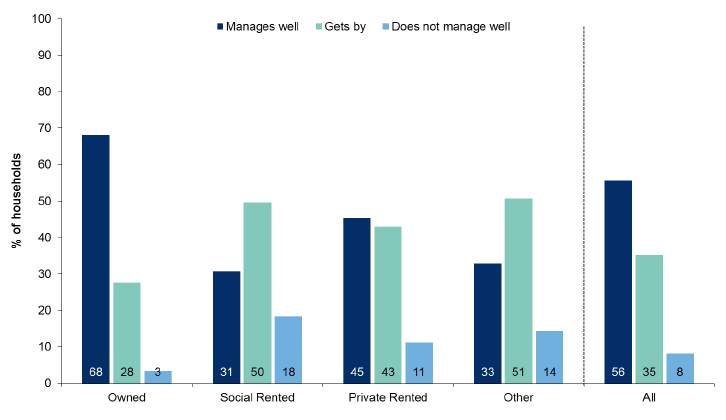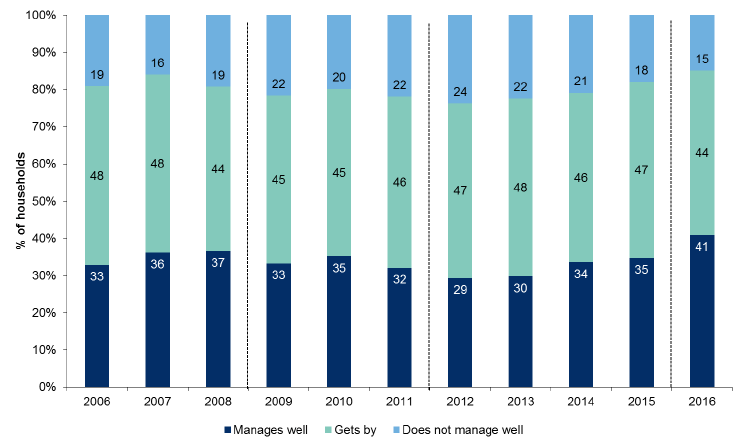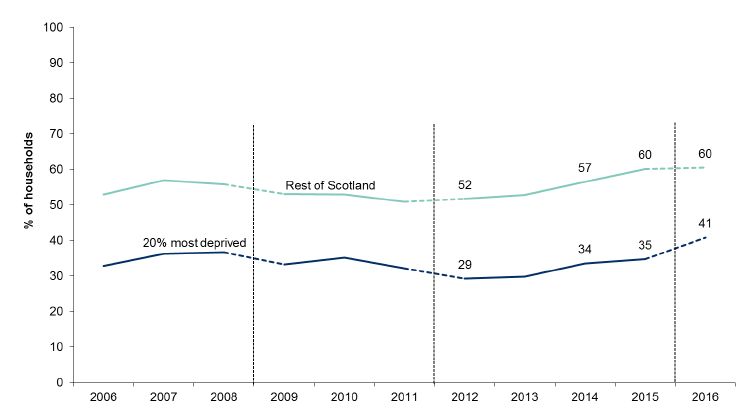Scottish household survey 2016: annual report
Results from the 2016 edition of the continuous survey based on a sample of the general population in private residences in Scotland.
6 Finance
Main Findings
The proportion of households reporting that they manage well financially increased from 48 per cent in 2013 to 56 per cent in 2016.
Single parent and single adult households were most likely to report that they do not manage well financially with around a fifth (20 and 15 per cent, respectively) reporting they do not manage well financially - higher than the overall Scotland figure of 8 per cent.
Households in the social rented sector were the least likely to say they were managing well (31 per cent) which is in contrast to owner occupiers and the private rented sector where 68 per cent and 45 per cent, respectively, reported that they were managing well.
The proportion of households in the 20 per cent most deprived areas who report they were managing well increased from 29 per cent in 2012 to 41 per cent in 2016.
Consistently over the last 10 years it has been shown that those in the 20 per cent most deprived areas manage less well than those in the rest of Scotland. However this gap has narrowed since 2012 and was 20 per cent in 2016.
6.1 Introduction and Context
The Scottish Government’s overall approach to tackling poverty and inequality is set out in the Fairer Scotland Action Plan, which was published in October 2016. The Plan is a response to the Fairer Scotland conversation, and is based around five ambitions for 2030:
- A Fairer Scotland for all
- Ending child poverty
- A strong start for all young people
- Fairer working lives
- A thriving third age
The ambitions are underpinned by 50 key actions that the Scottish Government will take during this Parliamentary term, including introducing a new socio-economic duty on public bodies, bringing forward a Child Poverty Bill, and establishing a national Poverty and Inequality Commission. A range of new steps to tackle poverty in the short term and inform consideration of fundamental changes for the longer term were also outlined in the 2017-18 Programme for Government. These include establishing a new £50 million Tackling Child Poverty Fund, providing access to free sanitary products to those in schools, colleges and universities, funding research into the feasibility of a citizens’ basic income scheme and providing a financial health check to families on low incomes..
6.2 How Households are Managing Financially
- There has been an increase in the amount of people who manage well since 1999.
- There has been a decrease in those with financial difficulties since 1999.
The SHS asks respondents to rate how they feel their households have coped financially over the last year. The trend since 1999 (when the survey started) is shown in Figure 6.1 below.
Between 1999 and 2007 there was a general increase in the proportion of households that reported positively about their household finances, rising from 42 per cent of households in 1999 to more than a half (53 per cent) in 2007. Between 2007 and 2010 this proportion fell to around a half of all households and remained stable until 2013. In 2016, over a half of households (56 per cent) reported they managed very or quite well, this has gradually increased from 48 per cent in 2013. The proportion of households that don’t manage very well and have some financial difficulties decreased by four per cent since its high in 2012 (12 per cent).
Figure 6.1: How households are managing financially by year
1999-2016 data, Households (minimum base: 3,660)

This question was only asked between January and March in 2003.
Variation by income
- More households on lower incomes (up to £10,000) said they did not manage well than those on higher incomes.
- Nearly three quarters (73 per cent) of all households with incomes over £30,000 reported managing well which much higher than with those on lower incomes.
Figure 6.2 shows the household perceptions of how they manage financially vary by household income. Households on lower incomes (up to £20,000) were as likely to say that they manage well as they were to say that they get by (43 and 44 per cent respectively). However, one in six households (16 per cent) on incomes up to £10,000 said they did not manage well - much higher than those on higher incomes.
There is a large gap between households with incomes over £30,000 and those below £30,000 - nearly three quarters (73 per cent) of all households with incomes over £30,000 reported managing well which is 16 percentage points higher than households with annual net income of £20,001 to £30,000 and 33 percentage points higher than households on the lower incomes up to £10,000.
Figure 6.2: How the household is managing financially this year by net annual household income
2016 data, Households (minimum base: 1,200)

Variation by household type
- Single parent households were the most likely to report that they were not managing well financially.
- Another group above the Scotland average were single adult households with around one in six (15 per cent) reporting that they were not managing well financially.
Table 6.1 shows how perceptions of management of household finances varied by household type. Single parent households were the most likely to report that they were not managing well financially with one in five (20 per cent) saying they are not managing well financially – this is more than double the proportion of all households in Scotland (8 per cent). Another group above the Scotland average were single adult households with around one in six (15 per cent) reporting that they were not managing well financially.
Table 6.1: How the household is managing financially this year by household type
Column percentages, 2016 data
| Households | Single adult | Small adult | Single parent | Small family | Large family | Large adult | Older smaller | Single older | All |
|---|---|---|---|---|---|---|---|---|---|
| Manages well | 45 | 64 | 30 | 55 | 45 | 60 | 70 | 61 | 56 |
| Gets by | 40 | 29 | 50 | 38 | 46 | 34 | 28 | 36 | 36 |
| Does not manage well | 15 | 7 | 20 | 8 | 9 | 6 | 2 | 4 | 8 |
| Total | 100 | 100 | 100 | 100 | 100 | 100 | 100 | 100 | 100 |
| Base | 2,040 | 1,880 | 600 | 1,290 | 520 | 860 | 1,550 | 1,630 | 10,380 |
Variation by household tenure
- Around two-thirds of owner occupiers reported managing well – more than double the proportion of households in social rented properties saying the same.
Perceptions of financial management are also associated with household tenure, as shown in Figure 6.3. Around two-thirds (68 per cent) of owner occupiers reported managing well – more than double the proportion of households in social rented properties saying the same (31 per cent). Almost one in five (18 per cent) social rented households reported not managing well which is more than double the rate of all households in Scotland (8 per cent). By contrast, only 11 per cent in the private rented sector and 3 per cent in the owner occupied sector reported that they were not managing well financially.
Figure 6.3: How the household is managing financially this year by tenure of household
2016 data, Households (minimum base: 130)

Variation by income source
- Households relying mainly on benefits were the most likely to say they are not managing well.
Table 6.2 shows how households were managing financially by their main income source. Households relying mainly on benefits (which includes recipients of the state pension) were the most likely to say they are not managing well with around one in seven (14 per cent) reporting that they were not managing well. Conversely only six per cent of households relying on earnings and two per cent of households relying on other sources [49] reported that they were not managing well.
Table 6.2: How the household is managing financially this year by income sources
Column percentages, 2016 data
| Households | Main income from earnings | Main income from benefits | Main income from other sources | All |
| Manages well | 59 | 43 | 79 | 56 |
|---|---|---|---|---|
| Gets by | 35 | 42 | 19 | 36 |
| Does not manage well | 6 | 14 | 2 | 8 |
| Total | 100 | 100 | 100 | 100 |
| Base | 5,490 | 3,400 | 1,120 | 10,020 |
Variation by gender and age
- Households where the Highest Income Householder ( HIH) was male were more likely to say they manage well.
- Increasing age of the highest income householder is also associated with managing well.
Households where the Highest Income Householder ( HIH) was male were more likely to say they do manage well ( Table 6.3) with three fifths saying so compared to a half of households where the highest income householder was female (60 per cent, compared with 50 per cent). Increasing age of the highest income householder is also associated with a higher percentage of households reporting that they were managing well.
Table 6.3: How the household is managing financially this year by gender and age of highest income householder
Column percentages, 2016 data
| Households | Male | Female | 16 to 24 | 25 to 34 | 35 to 44 | 45 to 59 | 60 to 74 | 75 plus | All |
|---|---|---|---|---|---|---|---|---|---|
| Manages well | 60 | 50 | 51 | 52 | 48 | 54 | 62 | 67 | 56 |
| Gets by | 33 | 39 | 41 | 38 | 38 | 36 | 34 | 31 | 36 |
| Does not manage well | 7 | 10 | 8 | 10 | 14 | 10 | 4 | 2 | 8 |
| Total | 100 | 100 | 100 | 100 | 100 | 100 | 100 | 100 | 100 |
| Base | 6,060 | 4,310 | 420 | 1,270 | 1,660 | 2,950 | 2,650 | 1,430 | 10,380 |
Variation by deprivation
- There are high levels of perceived financial difficulty in areas of deprivation.
- There has consistently been is a gap between those in deprived areas managing less well than those in the rest of Scotland.
- This gap has narrowed since 2012. This change is driven mainly by a decrease in the proportion of households reporting they were not managing well (in the 20 per cent most deprived areas).
The Scottish Index of Multiple Deprivation ( SIMD) is a relative measure of deprivation across small areas in Scotland. There are high levels of perceived financial difficulty in areas of deprivation (Table 6.4). More than double the proportion of households in the 20 per cent most deprived areas of Scotland said they were not managing well financially (15 per cent), compared with households in the rest of Scotland (six per cent).
Table 6.4: How the household is managing financially this year by Scottish Index of Multiple Deprivation [50]
Column percentages, 2016 data
| Households | 20% Most Deprived | Rest of Scotland | All |
|---|---|---|---|
| Manages well | 41 | 60 | 56 |
| Gets by | 44 | 33 | 36 |
| Does not manage well | 15 | 6 | 8 |
| Total | 100 | 100 | 100 |
| Base | 2,030 | 8,350 | 10,380 |
Figure 6.4 shows how this has changed over time. In 2012, almost a third (29 per cent) of households in the 20 per cent most deprived areas reported they were managing well. This has since then gradually increased. In 2016, 41 per cent of households in the 20 per cent most deprived areas reported they were managing well. This change is driven mainly by a decrease in the proportion of households reporting they were not managing well (24 per cent in 2012 compared with 15 per cent in 2016).
Figure 6.4: How households in the 20 per cent most deprived areas are managing financially over time
2006 - 2016 data, Households (minimum base: 5,500)

Note: The Scottish Index of Multiple Deprivation ( SIMD) is a relative measure of deprivation across small areas in Scotland. It is updated every few years. This analysis uses the SIMD measure which is relevant for each data year; SIMD06 for 2006 – 2008 data, SIMD09 for 2009 – 2011 data, SIMD12 for 2012 – 2015 data, and SIMD16 for 2016 data. Therefore, upon each update, some areas will shift away from being the most deprived. This creates “breaks” in the data which are represented by the dotted lines in the Figures 6.4 and 6.5.
Figure 6.5 compares the number of households who manage well financially in the 20 per cent most deprived areas with households in the rest of Scotland over time. There has consistently been a gap between those in the 20 per cent most deprived areas managing less well than those in the rest of Scotland. However this gap has narrowed since 2012. The proportion of households reporting they managed well has increased in both groups: in the 20 per cent most deprived areas this increased from 29 to 41 per cent, while in the rest of Scotland this increased from 52 to 60 per cent.
Figure 6.5: Households who manage well financially by year
2006 - 2016 data, Households (minimum base: 6,800)

* Based on the most recent available SIMD measure for each year; SIMD06, SIMD09, SIMD12 and SIMD16
While the gap between 2006 and 2016 isn’t smaller, the gap between 2012 and 2016 is smaller demonstrating a recent closing of gap on the persistent financial inequality.
Conclusion
This chapter has summarised Scottish Household Survey findings on how households in Scotland are managing financially. It has revealed an increasing proportion of households in Scotland managing well financially and a recent closing of the gap on the persistent financial inequality.
Contact
Email: Emma McCallum, emma.mccallum@gov.scot
Phone: 0300 244 4000 – Central Enquiry Unit
The Scottish Government
St Andrew's House
Regent Road
Edinburgh
EH1 3DG
There is a problem
Thanks for your feedback